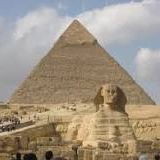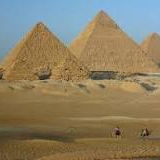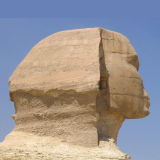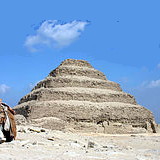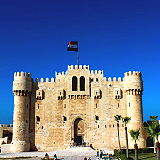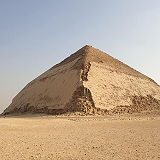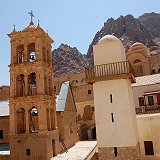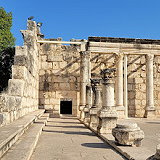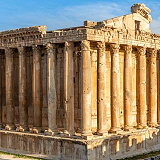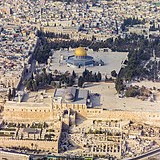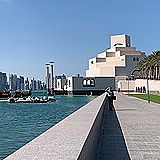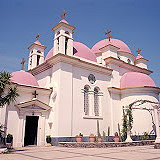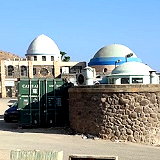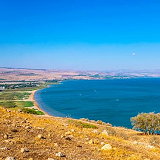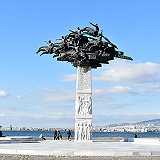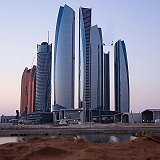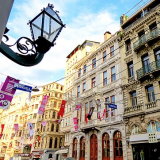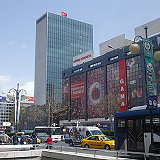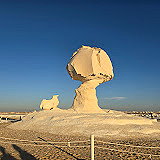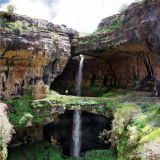| Giza Necropolis | |
| The Giza Necropolis is an iconic and ancient archaeological site located near the city of Giza in the Giza Governorate of Egypt. It is renowned for its massive pyramids, including the Great Pyramid of Giza, which is one of the Seven Wonders of the Ancient World. | |
| Great Pyramid of Giza | |
| The Great Pyramid of Giza, also known as the Pyramid of Khufu, is one of the most famous landmarks in Egypt and the world. It is located in Giza, just outside the city of Cairo, and is the largest of the three pyramids in the Giza pyramid complex. | |
| Great Sphinx of Giza | |
| The Great Sphinx of Giza is a massive statue of a mythical creature with the body of a lion and the head of a human that is located on the west bank of the Nile River in Giza, Egypt, near the Great Pyramid of Giza. It is one of the largest and most recognizable statues in the world and is a symbol of ancient Egyptian civilization. | |
| Saqqara Necropolis | |
| The Saqqara Necropolis is a vast ancient burial complex located in the Giza Governorate of Egypt. It is renowned for its historical significance, diverse range of tombs and structures, and the iconic Step Pyramid of Djoser. Saqqara features numerous pyramids, including the world-famous Step pyramid of Djoser,as well as a number of mastabas. Located some 30 km (19 mi) south of modern-day Cairo. | |
| Qaitbay Fort | |
| Qaitbay Fort, also known as the Citadel of Qaitbay, is a historic fortress located on the Mediterranean coast in Alexandria, Egypt. Visitors to Qaitbay Fort can explore its halls, chambers, and enjoy the scenic views from its towers. The fort stands as a testament to the historical significance of Alexandria as a major Mediterranean port and the efforts to protect it through the centuries. | |
| Bent Pyramid | |
| The Bent Pyramid is one of the pyramids built by King Sneferu, the first king of the Dynasty 4. It was called “bent” because of its broken lines due to a change of angle, an engineering issue in its design. Indeed, the pyramid construction began at an angle of 55 degrees but had to be adjusted to 43 degrees due to an overload of blocks resulting in instability. | |
| Saint Catherine's Monastery | |
| Saint Catherine's Monastery is a Christian monastery located in the Sinai Peninsula of Egypt. Located at the foot of Mount Sinai, it was built between 548 and 565, and is the world's oldest continuously-inhabited Christian monastery. | |
| Capernaum Synagogue | |
| The Capernaum Synagogue also known as the White Synagogue is a fourth century CE Jewish temple in the ancient fishing village of Capernaum, built on the remains of an earlier first century CE synagogue. The synagogue of Capernaum is located just inland from the shore with its facade facing Jerusalem. | |
| Temple of Bacchus | |
| The Temple of Bacchus in Baalbek is one of the best-preserved ancient Roman temples in the world, and it's dedicated to Bacchus, the god of wine, revelry, and ecstasy. Built in the 2nd century AD, this temple is often overshadowed by the nearby, larger Temple of Jupiter but is remarkable for its detailed craftsmanship and architectural sophistication. | |
| Israel | |
| Israel is a country located in the Middle East, bordered by Lebanon to the north, Syria to the northeast, Jordan to the east, and Egypt to the southwest. Tel Aviv is the economic and technological center of the country, while its seat of government is in its proclaimed capital of Jerusalem. As of 31 December 2022, Israel's population was an estimated 9,656,000. In 2022. | |
| Museum of Islamic Art | |
| The Museum of Islamic Art (MIA) is a museum on one end of the seven-kilometer-long (4.3 mi) Corniche in Doha, Qatar. It has been presenting a programme of temporary exhibitions which illuminate the heritage of Islamic cultures across the globe. | |
| Monastery of the Holy Apostles | |
| The Greek Orthodox Church of the Holy Apostles is the church at the centre of the Greek Orthodox Monastery of the Holy Apostles at Capernaum, standing among the ruins of ancient Capernaum (Kfar Nachum) near the shore of the Sea of Galilee in Israel. | |
| Tomb of Rabbi Meir | |
| The site of the holy Tanna Rabbi Meir Baal Hanes is in the city of Tiberias and has been an inexhaustible spring of blessings and salvation for every one of the children of Israel who came to beg God to win salvation and mercy, thanks to the Tanna in this holy place. | |
| Sea of Galilee | |
| The Sea of Galilee (the Kinneret) is a magnificent geographical marvel surrounded by pretty rural agricultural settlements. It’s famous because of its prominence among New Testament writings. The whole of the Galilee is since this is the place where Jesus lived. | |
| Izmir | |
| İzmir is the third most populous city in Turkey, after Istanbul and Ankara. It is on the Aegean coast of Anatolia, and is the capital of İzmir Province. In 2024, the city of İzmir had a population of 2,938,292 (in eleven urban districts), while İzmir Province had a total population of 4,493,242. | |
| Etihad Towers | |
| Etihad Towers is a complex of buildings with five towers in Abu Dhabi, the capital city of the United Arab Emirates. With five stunning towers that sparkle iridescently in the never-ending sunshine, Etihad Towers is a reflection of everything that Abu Dhabi is and will be: Modern, Sophisticated and Luxirious ... | |
| İstiklal Caddesi | |
| The two-mile pedestrian boulevard is a must-see for any visitor to İstanbul. Formerly known as Grande Rue de Péra, the street was renamed İstiklal Caddesi or Independence Avenue in 1923. The bustling street is lined with late Ottoman-era buildings built in a variety of architectural styles, from neoclassicism to art deco. | |
| Ankara | |
| Ankara, the capital of Turkey, lies in the heart of Anatolia at an altitude of 850 meters. Known in ancient times as Ankyra (meaning “anchor”) or Ancyra, it was an important cultural, trading and arts center in the Roman period, and a trading hub on the caravan route to the east in the Ottoman era. The city has a population of 5,290,822 in its urban center and 5,864,049 in Ankara Province in 2024. | |
| White Desert National Park | |
| White Desert National Park in Egypt is the site of large white chalk rock formations, created through erosion by wind and sand. It is also the site of cliffs, sand dunes, as well as Wadi Hennis and oases at Ain El Maqfi and Ain El Wadi. The highest point in the park is at El Qess Abu Said at 353 m (1,158 ft) above sea level, and the lowest is at Wadi Hennis at 32 m (105 ft). | |
| Baatara Gorge Waterfall | |
| The Baatara Gorge Waterfall, also known as the Three Bridges Waterfall, is a stunning natural attraction located in the village of Meghraq in Lebanon. The Baatara Gorge Waterfall is formed by a series of limestone caves and a sinkhole. The water plunges through a vertical shaft, creating a breathtaking waterfall that cascades into a deep gorge below. | |
